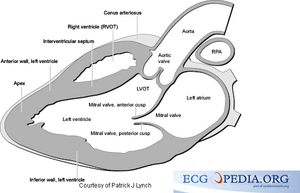Parasternal long axis: Difference between revisions
Jump to navigation
Jump to search
No edit summary |
No edit summary |
||
| Line 8: | Line 8: | ||
The left parasternal long axis is usually the first view of the echocardiographic examination. | The left parasternal long axis is usually the first view of the echocardiographic examination. | ||
{{clr}} | |||
[[Image:echo_heart_parasternal_long_axis.jpg|thumb|Image showing the left parasternal long axis transection (PSLAX) of the heart by the ultrasound waves]] | [[Image:echo_heart_parasternal_long_axis.jpg|thumb|Image showing the left parasternal long axis transection (PSLAX) of the heart by the ultrasound waves]] | ||
{{clr}} | {{clr}} | ||
The | The following structures can be visualized with the PLAX: | ||
[[Image:PLAXLynch.png|thumb]] | [[Image:PLAXLynch.png|thumb]] | ||
==Schematic view== | ==Schematic view== | ||
Revision as of 13:50, 25 September 2007
Content is incomplete and may be incorrect. |
| Author | I.A.C. van der Bilt | |
| Moderator | I.A.C. van der Bilt | |
| Supervisor | ||
| some notes about authorship | ||
The left parasternal imaging planes are found by placing the transducer in the third or fourth intercostal space on the left of the sternum.
The left parasternal long axis is usually the first view of the echocardiographic examination.
The following structures can be visualized with the PLAX:
Schematic view
Position of the transducer on the chest and schematic echocardiographic view
Example
This a parasternal long axis view of a normal heart.
| <flash>file=PSLAX.swf |
| A parasternal long axis |

